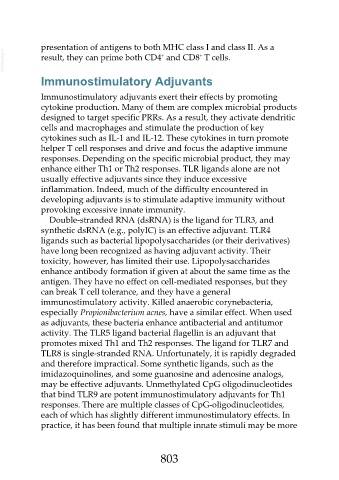Page 803 - Veterinary Immunology, 10th Edition
P. 803
presentation of antigens to both MHC class I and class II. As a
VetBooks.ir result, they can prime both CD4 and CD8 T cells.
+
+
Immunostimulatory Adjuvants
Immunostimulatory adjuvants exert their effects by promoting
cytokine production. Many of them are complex microbial products
designed to target specific PRRs. As a result, they activate dendritic
cells and macrophages and stimulate the production of key
cytokines such as IL-1 and IL-12. These cytokines in turn promote
helper T cell responses and drive and focus the adaptive immune
responses. Depending on the specific microbial product, they may
enhance either Th1 or Th2 responses. TLR ligands alone are not
usually effective adjuvants since they induce excessive
inflammation. Indeed, much of the difficulty encountered in
developing adjuvants is to stimulate adaptive immunity without
provoking excessive innate immunity.
Double-stranded RNA (dsRNA) is the ligand for TLR3, and
synthetic dsRNA (e.g., polyIC) is an effective adjuvant. TLR4
ligands such as bacterial lipopolysaccharides (or their derivatives)
have long been recognized as having adjuvant activity. Their
toxicity, however, has limited their use. Lipopolysaccharides
enhance antibody formation if given at about the same time as the
antigen. They have no effect on cell-mediated responses, but they
can break T cell tolerance, and they have a general
immunostimulatory activity. Killed anaerobic corynebacteria,
especially Propionibacterium acnes, have a similar effect. When used
as adjuvants, these bacteria enhance antibacterial and antitumor
activity. The TLR5 ligand bacterial flagellin is an adjuvant that
promotes mixed Th1 and Th2 responses. The ligand for TLR7 and
TLR8 is single-stranded RNA. Unfortunately, it is rapidly degraded
and therefore impractical. Some synthetic ligands, such as the
imidazoquinolines, and some guanosine and adenosine analogs,
may be effective adjuvants. Unmethylated CpG oligodinucleotides
that bind TLR9 are potent immunostimulatory adjuvants for Th1
responses. There are multiple classes of CpG-oligodinucleotides,
each of which has slightly different immunostimulatory effects. In
practice, it has been found that multiple innate stimuli may be more
803

